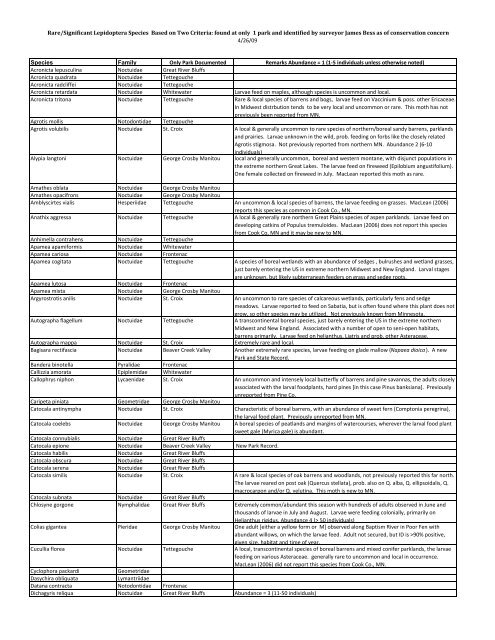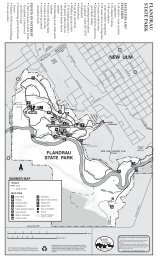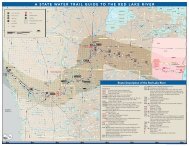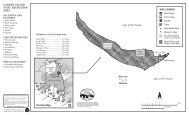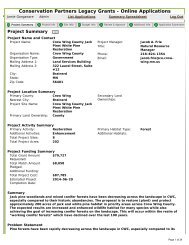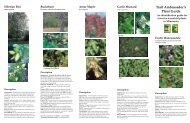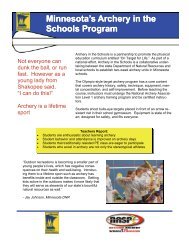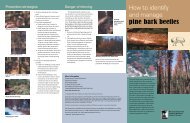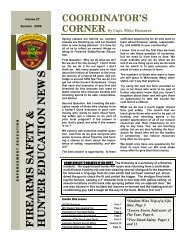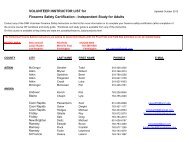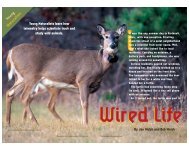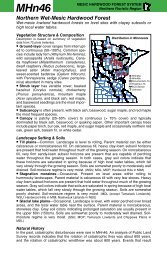A survey of Lepidoptera in three priority areas of the Minnesota state ...
A survey of Lepidoptera in three priority areas of the Minnesota state ...
A survey of Lepidoptera in three priority areas of the Minnesota state ...
You also want an ePaper? Increase the reach of your titles
YUMPU automatically turns print PDFs into web optimized ePapers that Google loves.
Rare/Significant <strong>Lepidoptera</strong> Species Based on Two Criteria: found at only 1 park and identified by <strong>survey</strong>or James Bess as <strong>of</strong> conservation concern<br />
4/26/09<br />
Species Family Only Park Documented Remarks Abundance = 1 (1‐5 <strong>in</strong>dividuals unless o<strong>the</strong>rwise noted)<br />
Acronicta lepuscul<strong>in</strong>a Noctuidae Great River Bluffs<br />
Acronicta quadrata Noctuidae Tettegouche<br />
Acronicta radcliffei Noctuidae Tettegouche<br />
Acronicta retardata Noctuidae Whitewater Larvae feed on maples, although species is uncommon and local.<br />
Acronicta tritona Noctuidae Tettegouche Rare & local species <strong>of</strong> barrens and bogs, larvae feed on Vacc<strong>in</strong>ium & poss. o<strong>the</strong>r Ericaceae.<br />
In Midwest distrbution tends to be very local and uncommon or rare. This moth has not<br />
previously been reported from MN.<br />
Agrotis mollis Notodontidae Tettegouche<br />
Agrotis volubilis Noctuidae St. Croix A local & generally uncommon to rare species <strong>of</strong> nor<strong>the</strong>rn/boreal sandy barrens, parklands<br />
and prairies. Larvae unknown <strong>in</strong> <strong>the</strong> wild, prob. feed<strong>in</strong>g on forbs like <strong>the</strong> closely related<br />
Agrotis stigmosa. Not previously reported from nor<strong>the</strong>rn MN. Abundance 2 (6‐10<br />
<strong>in</strong>dividuals)<br />
Alypia langtoni Noctuidae George Crosby Manitou local and generally uncommon, boreal and western montane, with disjunct populations <strong>in</strong><br />
<strong>the</strong> extreme nor<strong>the</strong>rn Great Lakes. The larvae feed on fireweed (Epilobium angustifolium).<br />
One female collected on fireweed <strong>in</strong> July. MacLean reported this moth as rare.<br />
Ama<strong>the</strong>s oblata Noctuidae George Crosby Manitou<br />
Ama<strong>the</strong>s opacifrons Noctuidae George Crosby Manitou<br />
Amblyscirtes vialis Hesperiidae Tettegouche An uncommon & local species <strong>of</strong> barrens, <strong>the</strong> larvae feed<strong>in</strong>g on grasses. MacLean (2006)<br />
reports this species as common <strong>in</strong> Cook Co., MN.<br />
Anathix aggressa Noctuidae Tettegouche A local & generally rare nor<strong>the</strong>rn Great Pla<strong>in</strong>s species <strong>of</strong> aspen parklands. Larvae feed on<br />
develop<strong>in</strong>g catk<strong>in</strong>s <strong>of</strong> Populus tremuloides. MacLean (2006) does not report this species<br />
from Cook Co, MN and it may be new to MN.<br />
Anhimella contrahens Noctuidae Tettegouche<br />
Apamea apamiformis Noctuidae Whitewater<br />
Apamea cariosa Noctuidae Frontenac<br />
Apamea cogitata Noctuidae Tettegouche A species <strong>of</strong> boreal wetlands with an abundance <strong>of</strong> sedges , bulrushes and wetland grasses,<br />
just barely enter<strong>in</strong>g <strong>the</strong> US <strong>in</strong> extreme nor<strong>the</strong>rn Midwest and New England. Larval stages<br />
are unknown, but likely subterranean feeders on grass and sedge roots.<br />
Apamea lutosa Noctuidae Frontenac<br />
Apamea mixta Noctuidae George Crosby Manitou<br />
Argyrostrotis anilis Noctuidae St. Croix An uncommon to rare species <strong>of</strong> calcareous wetlands, particularly fens and sedge<br />
meadows. Larvae reported to feed on Sabatia, but is <strong>of</strong>ten found where this plant does not<br />
grow, so o<strong>the</strong>r species may be utilized. Not previously known from M<strong>in</strong>nesota.<br />
Autographa flagellum Noctuidae Tettegouche A transcont<strong>in</strong>ental boreal species, just barely enter<strong>in</strong>g <strong>the</strong> US <strong>in</strong> <strong>the</strong> extreme nor<strong>the</strong>rn<br />
Midwest and New England. Associated with a number <strong>of</strong> open to seni‐open habitats,<br />
barrens primarily. Larvae feed on helianthus, Liatris and prob. o<strong>the</strong>r Asteraceae.<br />
Autographa mappa Noctuidae St. Croix Extremely rare and local.<br />
Bagisara rectifascia Noctuidae Beaver Creek Valley Ano<strong>the</strong>r extremely rare species, larvae feed<strong>in</strong>g on glade mallow (Napaea dioica ). A new<br />
Park and State Record.<br />
Bandera b<strong>in</strong>otella Pyralidae Frontenac<br />
Callizzia amorata Epiplemidae Whitewater<br />
Callophrys niphon Lycaenidae St. Croix An uncommon and <strong>in</strong>tensely local butterfly <strong>of</strong> barrens and p<strong>in</strong>e savannas, <strong>the</strong> adults closely<br />
associated with <strong>the</strong> larval foodplants, hard p<strong>in</strong>es [<strong>in</strong> this case P<strong>in</strong>us banksiana]. Previously<br />
unreported from P<strong>in</strong>e Co.<br />
Caripeta p<strong>in</strong>iata Geometridae George Crosby Manitou<br />
Catocala ant<strong>in</strong>ympha Noctuidae St. Croix Characteristic <strong>of</strong> boreal barrens, with an abundance <strong>of</strong> sweet fern (Comptonia peregr<strong>in</strong>a),<br />
<strong>the</strong> larval food plant. Previously unreported from MN.<br />
Catocala coelebs Noctuidae George Crosby Manitou A boreal species <strong>of</strong> peatlands and marg<strong>in</strong>s <strong>of</strong> watercourses, wherever <strong>the</strong> larval food plant<br />
sweet gale (Myrica gale) is abundant.<br />
Catocala connubialis Noctuidae Great River Bluffs<br />
Catocala epione Noctuidae Beaver Creek Valley New Park Record.<br />
Catocala habilis Noctuidae Great River Bluffs<br />
Catocala obscura Noctuidae Great River Bluffs<br />
Catocala serena Noctuidae Great River Bluffs<br />
Catocala similis Noctuidae St. Croix A rare & local species <strong>of</strong> oak barrens and woodlands, not previously reported this far north.<br />
The larvae reared on post oak (Quercus stellata), prob. also on Q. alba, Q. ellipsoidalis, Q.<br />
macrocarpon and/or Q. velut<strong>in</strong>a. This moth is new to MN.<br />
Catocala subnata Noctuidae Great River Bluffs<br />
Chlosyne gorgone Nymphalidae Great River Bluffs Extremely common/abundant this season with hundreds <strong>of</strong> adults observed <strong>in</strong> June and<br />
thousands <strong>of</strong> larvae <strong>in</strong> July and August. Larvae were feed<strong>in</strong>g colonially, primarily on<br />
Helianthus rigidus. Abundance 4 (> 50 <strong>in</strong>dividuals)<br />
Colias gigantea Pieridae George Crosby Manitou One adult [ei<strong>the</strong>r a yellow form or M] observed along Baptism River <strong>in</strong> Poor Fen with<br />
abundant willows, on which <strong>the</strong> larvae feed. Adult not secured, but ID is >90% positive,<br />
given size, habitat and time <strong>of</strong> year.<br />
Cucullia florea Noctuidae Tettegouche A local, transcont<strong>in</strong>ental species <strong>of</strong> boreal barrens and mixed conifer parklands, <strong>the</strong> larvae<br />
feed<strong>in</strong>g on various Asteraceae. generally rare to uncommon and local <strong>in</strong> occurrence.<br />
MacLean (2006) did not report this species from Cook Co., MN.<br />
Cyclophora packardi Geometridae<br />
Dasychira obliquata Lymantriidae<br />
Datana contracta Notodontidae Frontenac<br />
Dichagyris reliqua Noctuidae Great River Bluffs Abundance = 3 (11‐50 <strong>in</strong>dividuals)


